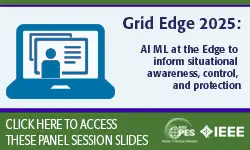Protection Challenges and Practices for Interconnecting Inverter Based Resources to Utility Transmission Systems
Members and Contributors: Abu Bapary, Jeff Barsch, Michael Bloder, Sukumar Brahma, Duane Buchanan, Ritwik Chowdhury, James Deaton, Randy Cunico, Alla Deronja, Rui Fan, Evangelos Farantatos, Kamal Garg, Yanfeng Gong, Frank Gotte, Jean-Francois Hache, Ali Hooshyar, Addis Kifle, Hillmon Ladner, Bruce Magruder, Jezze Martinez , David Morrissey, Krish Narendra, Andrew Nguyen, Manish Patel, Nuwan Perera, Joe Perez, Dan Reckerd, John Seuss, Jim van de Ligt, Amin Zamani
-
Members: FreePES
IEEE Members: $45.00
Non-members: $70.00Pages/Slides: 65
Technical Report
20 Jul 2020
Rapid growth in interconnection of solar photovoltaic and Type III or IV wind energy conversion sources to the transmission system is creating new challenges for protection engineers. Unlike synchronous resources, these new energy conversion sources connect to the grid with full or partial power electronic interfaces that are referred to as inverter-based resource (IBR). Protection challenges are introduced because the output current of an IBR facility is very different from a traditional rotating synchronous source facility during short circuit conditions. Current from a synchronous source is of high magnitude, uncontrolled and has well defined short circuit characteristic. However, the short circuit current of the IBR is of low magnitude, highly controlled and managed by using fast switching of power electronics devices dependent upon manufacturer specific control system design. Thus, an IBR has low-magnitude and non-universal short circuit current characteristic.
Traditional protection schemes, which largely rely upon high magnitude and high inductive nature of the short circuit current, may not provide reliable protection when operating on controlled current supplied by an IBR. Not taking into account the differing nature of IBR behavior, traditional line protection may incorrectly trip for some external short circuits or may not trip on other internal short circuits. This report describes protection challenges associated with interconnection of IBR facilities, suggests solutions, and documents lessons learned from the present limited experiences thus far. The goal of the report is to provide a resource to assist protection engineers in the successful integration of IBR to the electric power grid using multifunction relaying devices available in the marketplace.
Traditional protection schemes, which largely rely upon high magnitude and high inductive nature of the short circuit current, may not provide reliable protection when operating on controlled current supplied by an IBR. Not taking into account the differing nature of IBR behavior, traditional line protection may incorrectly trip for some external short circuits or may not trip on other internal short circuits. This report describes protection challenges associated with interconnection of IBR facilities, suggests solutions, and documents lessons learned from the present limited experiences thus far. The goal of the report is to provide a resource to assist protection engineers in the successful integration of IBR to the electric power grid using multifunction relaying devices available in the marketplace.
Chairs:
Chair: Mukesh Nagpal
Vice-Chair: Mike Jensen
Secretary: Michael Higginson
Vice-Chair: Mike Jensen
Secretary: Michael Higginson
Primary Committee:
Power System Relaying and Control Committee (PSRC)
Sponsor Committees:
Subcommittee C - System Protection, Working Group C32


